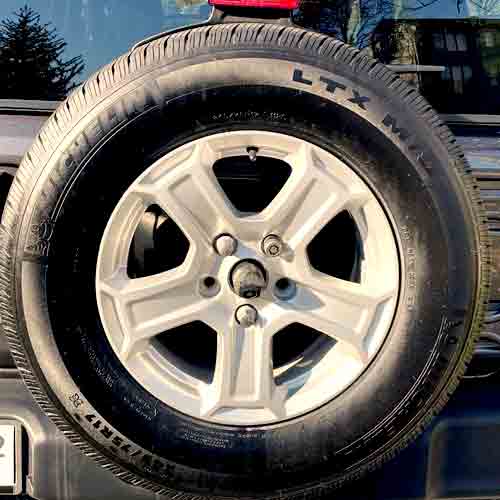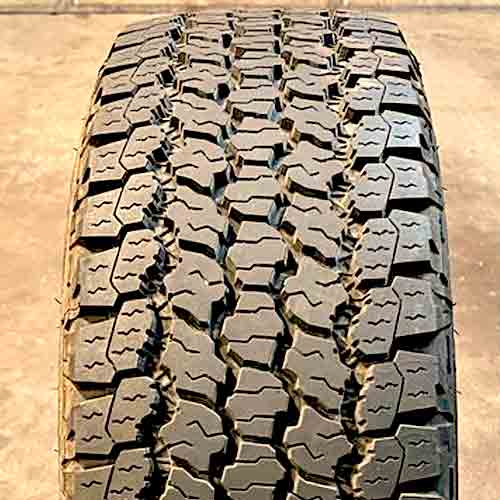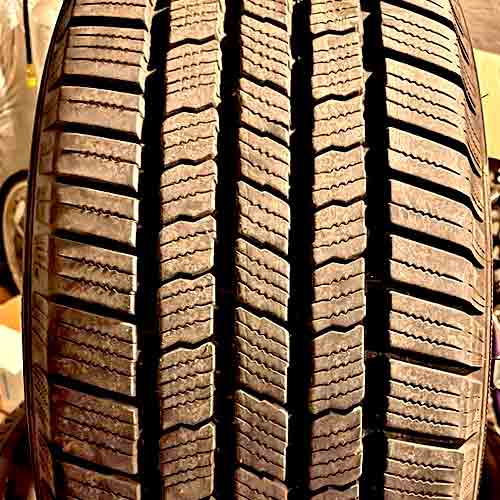Whether you’re driving a 1-ton pickup truck or a body-on-frame SUV, both the Goodyear Wrangler Adventure and the Michelin Defender LTX M/S have been engineered to provide with above-average performance on and off road. Let check them out in more detail.

In my expert opinion as a tire engineer, my testing showed me Michelin Defender performing better on wet/dry highways, in terms of traction, comfort, fuel efficiency and tread mileage. Whereas the Goodyear Adventure supplies better off-road traction, well, except for sandy terrains.
Table of Contents
Sizes Facts
Starting things off with Michelin Defender LTX M/S, the tire has following specs:
- Sizes: 73 (15 to 22″ rims).
- Speed ratings: R, T and H.
- Load ratings: SL, XL, C and E.
- Tread depth: 10 to 13/32″.
- Weight range: 25 to 60 lbs.
- 3PMSF not available.
- Treadwear warranty: 70k miles for P metric, and 50k for LT.
Detailed review of this tire: https://tiredriver.com/michelin-defender-ltx-ms-review/
Goodyear Wrangler Adventure Kevlar, on the other side, comes in 15 to 20 inches, having following specs:
- Speed ratings: R, S, T and H.
- Load ratings: SL, XL, C and E.
- Weight range: 34 to 60 lbs.
- Tread depth: 12/32″ or 15/32″.
- Ratings: 3PMSF and M+S.
- Warranty: 60k for all sizes.
- Only LT sizes have 3PMSF ratings.
Note: Although both tires have 2 ply sidewalls, with Kevlar reinforcements, the Goodyear Adventure brings in greater protection (LT sizes have 30% more steel in their internal construction).
Tread Appearance
Starting with Goodyear Adventure, the tread makes a very highway friendly design.

Starting from the middle:
- There are 3 ribs here making 4 vertical grooves.
- The middle most rib is slightly wider and more longitudinally streamlined, providing on-road grip.
- Surrounding ribs have greater (no. of) biters, so they get to offer most of the traction off-road.
- They also make wider lateral grooves, which interconnect with the outer circumferential voids.
- These outer channels have multiple stone ejectors (in them, on the base), allowing for self cleaning of the tread on rugged tracks, filled with dirt and debris.
On shoulders:
- The lugs are biggest and elongated.
- They provide the most off-set edges, and sipes on the tread.
- And while the inner edges have a lot more biters, their outer margins are still not staggered.
- These lugs join up together on sidewalls, rendering on-road lateral stability and at the same time traction off-road.
On the other side, we get to have a more on-road oriented tire, the Michelin Defender LTX M/S.

From the middle:
- There are 3 ribs, consisting of very squared-off blocks.
- All of them have similar full depth wave-like siping, and off-set edges.
- They also make in-groove notches from their lateral grooves.
- All these ribs together make 4 aqua channels of same width.
Towards shoulders:
- These lugs are bigger compared to middle ones (as they are elongated).
- But other than that, they carry similar siping pattern and off-set edges, though their lateral tread voids are bigger here, and not interlocking.
- These lugs are also not staggered on the outer margins, and the tire doesn’t offer any sidewall lugs, which makes sense, given its an all-season tire.
Dry Traction
When evaluating an all-terrain tire’s dry performance, you must consider factors such as traction, the tire’s ability to steer, and its cornering stability. Let’s examine these key elements in more detail.
Dry Grip
How well a tire brakes on “dry” roads determines this grip, also called directional grip, since we are moving straight here.
And as the central section depends on the middle part of the tread, how stable is the tire making connection with the road is significant.
That’s why Michelin Defender LTX MS is taking is the lead with it’s closed up blocks (longitudinally).
The Goodyear Adventure, in comparison has greater lateral grooves, which literally break the connection with the road while rolling.
Handling And Steering Response
The tire’s handling although also depends on the contact patch (of mostly shoulders, which bear the most weight, during turns), here tread flexibility is also a key factor.
Out of both tires, we already know how Defender offers superior contact with the road, but the thing is it’s connection with the ground is also much more stable.
It’s lugs aren’t irregularly shaped like seen on the Goodyear Adventure, and they have less tread depth, so they don’t flex as much as the tire corners, resulting in better under and over steering balance, unlike it’s competitor.
And naturally this results in superior handling capabilities.
Wet Performance
Improving wet traction requires consideration of two key aspects: wet grip and resistance to hydroplaning. Let’s dig in to them both.
Wet Grip
The siping is very important here, they help by creating a suction (pushing air out), and soaking up water underneath.
So with greater number of sipes, the Michelin Defender LTX MS is again taking the lead.
The Wrangler Adventure not only offers as much siping slits on it’s tread, they are also not as interlocking, so water clear abilities on this tire is limited, comparatively.
Note: Interlocking sipes have wave-like structure, which are more effective in creating negative pressure for the water molecules.
Hydroplaning
The phenomenon of hydroplaning, also known as aquaplaning, happens when a tire starts to float (with it’s formation of water layer between the surface and the tread). This happens when water is not pushed out of the tread in time.
So faster the water evacuation, the more resistant the tire gets to hydroplaning.
So it makes sense why both tires do great here, though the Goodyear Adventure with it’s balder structure is slightly more capable in comparison.
Fuel Efficiency
Although both these tires have designs which may not perform well in terms of fuel efficiency, it’s still important to understand their performance for long-term gains.
That’s why it makes sense why one is better than the other, (evaluated though analyzing their tread compositions and weights).
Both tires although features similar weighing sizes on average, they Michelin LTX MS still consumes less overall fuel consumption due to it’s resistant lug maneuverability.
As I mentioned in the handling section, it’s lugs are more packed up and they don’t bent too much with the tire accelerating and cornering. So less energy gets wasted there (in to molding of tread), and more is focused in rolling of the tire.
The Wrangler Adventure on the other hand, does things on the slip side, as it’s lugs are not as supported together.
Treadwear
The durability of a tire’s tread is not only seen off-road but also in terms of tread life, that’s the Michelin Defender LTX MS with it’s Evertread tread compound offers a longer lasting rubber.
Moreover, it’s sizes although have similar structural weight (on average, comparatively), each of its tread blocks with closed up design carry less pressure on itself.
Whereas with wider gaps, on Goodyear Wrangler All-Terrain Adventure lugs bear more burden, and burn off the surface with greater friction, resulting in relatively faster treadwear.
Ride Noise
Noise has to do with air-flow, and so with a balder structure the Wrangler A/T Adventure offers greater area for that air to bump around, generating noise (it’s tread blocks aren’t only spacious, but also carry more tread depth).
Whereas on Michelin Defender LTX MS, air particles don’t get to have as much tread depth or voids, to strike with. So the tire produces a comparatively quieter ride.
Winter Traction
Winter performance is a very challenging terrain as it’s tricky to avoid slippage here. Though with new gen tread compound and having a ton of biters, the Wrangler Adventure is taking the lead.
It’s biters basically trap snow particles in, and make contact with the snowy ground with that lodged snow. This offers greater frictional values compared to a rubber-to-snow contact.
That’s why Defender LTX MS with lacking biters can’t produce similar results, and it makes sense why the tire is missing with 3 Peak Mountain Snowflake symbol unlike the Wrangler Adventure.
Off Road Traction
Different terrains require different skills from tires when navigating beaten paths. That’s why I judged these boys on these following terrain types.
Muddy Tracks
On muddy tracks, you want self cleaning tread, and that’s only applicable with wider tread voids, as seen on mud-terrain tires.
That’s why both of these tires although aren’t that capable, at-least you get a better response on lighter tracks with Goodyear Adventure, as the tire is a bit more bald.
Rocky Trails
On rocky terrains, there are a lot of things to look for. First stop is durability and here, although both tires offer similar 2 ply polyester construction, the Goodyear Adventure coming in with Kevlar reinforcements and more steel in it’s steel belts (on LT sizes) supplies better efficacy.
Second, is the traction, and here again the tire with greater number of biters and bigger groove mouth supplies grip in all directions.
The longitudinally angled lugs on Defender LTX M/S can’t offer similar gripping capabilities.
On Sand
Have you ever considered, why the tire’s air pressure is so important on sandy dunes? Well, this is because lowering it helps with the tire’s ability to float.
And since there are other factors at play too, which help the tire to stay afloat, such as weight, sidewalls, tread structure and so on, it can be easily explained why I prefer the Defender LTX MS here.
As already mentioned in the tread life section, the tire puts less pressure on its lugs, so it’s not that susceptible to digging.
Whereas the Wrangler Adventure not only puts more weight on the surface of the soft sand, but it’s outer sidewalls are stiffer and more biting as well. So maintaining its forward momentum is a bit more challenging, relatively.
Gravely Roads
To ensure smooth and safe off-road driving on gravely roads, self-cleaning grooves are a must for off-road tires, as cut-resistant rubber alone cannot prevent stones and dirt from getting stuck.
That’s why its obvious why Goodyear Wrangler Adventure is a more gripping tire in this area. It’s spacious structure is already not that inviting to the debris and sharp rocks, and with ti’s outer circumferential grooves filled with multiple stone ejectors on the base, it faster improve it’s efficacy.
The Michelin Defender LTX MS on the other side, is missing with any kind of these ejectors and it’s closed up voids are more prone to holding on to sharp stones.
These reduce overall traction abilities and damages the tread with it as well.
Leave With This
Out of both tires the Michelin LTX MS being an all season tire offers better results in all on-road performance metrics.
It’s better in terms of gripping and steering response (on both wet and dry asphalts), and it does great reducing on-road noise, brings better tread life, and supplies superior fuel economy.
The Goodyear Wrangler Adventure on the other hand, although is only lacking by a margin on dry roads, it’s wet traction can be improved a good deal.
Though the tire makes up for it on rugged tracks, with it’s superior gripping abilities.
Very informative review thank you looking at new tires for 2019 ram 1500 buddy of mine has the Goodyear tires I am leaning towards the Michelin